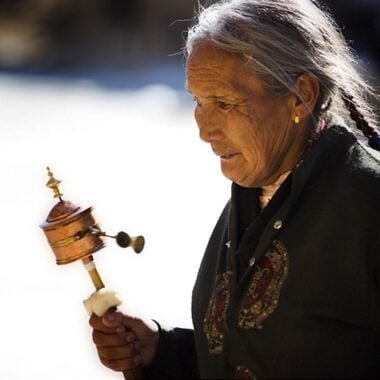Sipping Serenity: A Journey into Tibet’s Cozy Tea House Culture
Introduction In Tibet, tea houses are more than cafés—they’re living rooms of the soul. Stepping into one feels like slipping into a…
Introduction
In Tibet, tea houses are more than cafés—they’re living rooms of the soul. Stepping into one feels like slipping into a sunlit cocoon of cardamom-scented steam, where weathered hands cradle porcelain bowls and laughter dances with murmured mantras. For travelers craving authenticity, these havens offer a taste of Tibetan life, one buttery sip at a time.
The Tea House Scene: A Symphony of Senses
Ambiance: Warmth in Every Corner
Faded thangka paintings curl on smoke-stained walls. Sunlight slants through steamed windows, illuminating copper kettles and wooden benches polished smooth by generations of elbows. Locals in chubas (wool robes) huddle over chessboards, their prayer beads draped like amber necklaces. A radio crackles with Tibetan ballads, competing with the hiss of a pressure cooker preparing momo dumplings.
The Star of the Show: Tibetan Butter Tea (“Po Cha”)
Crafting the Brew
Watch the tea master at work:
1. Brick Tea: Boil fermented black tea leaves from Pemagul, aged like wine.
2. Churning: Pour the brew with yak butter and salt into a dongmo (wooden churn), pumping vigorously until frothy.
3. Serving: Decanted into thermoses, the tea stays piping hot for hours.
Taste & Ritual
Your first sip shocks—salty, creamy, earthy, like a brothy latte. Locals drink it in rhythmic gulps, refilling bowls before they empty. Pair it with tsampa (roasted barley flour) rolled into dough balls—a survival snack honed by nomads.
Sweet Escapes: Tea House Delicacies
1. Tibetan Sweet Milk Tea
– A gentler cousin of butter tea, blending black tea, fresh yak milk, and rock sugar. Topped with crushed walnuts.
2. Sha Phaley (Fried Meat Pies)
– Crisp dough stuffed with spiced yak meat and cabbage. Tear open to release fragrant steam.
3. Dresi (Sweet Rice Pudding)
– Sticky rice soaked in saffron milk, dotted with raisins and dried apricots. Served in lacquered boxes.
4. Khapse (Deep-Fried Twists)
– Crunchy, golden pastries dusted with sugar—Tibet’s answer to churros.
A Day in a Lhasa Tea House: Moments to Savor
Morning (8–10 AM):
Elders debate politics over thenthuk (noodle soup). A monk scribbles scripture in a notebook, his tea bowl eternally half-full.
Noon (12–2 PM):
Office workers slurp yak bone broth with tingmo (steamed bread). A grandmother teaches her granddaughter to spin a prayer wheel.
Evening (5–7 PM):
Sunset gilds the Barkhor Street tea houses. Backgammon pieces clack as travelers swap stories over honey-drenched balep bread.
Why Tea Houses Captivate
– Time Warp: No Wi-Fi, no rush—just the hypnotic pour of tea and the creak of wooden floors.
– Cultural Bridge: Share a thermos with a stranger; smiles need no translation.
– Pure Ingredients: Yak butter from free-grazing herds, barley from terraced fields, honey wild-harvested from Himalayan cliffs.
Tea House Etiquette: 7 Rules to Blend In
1. Sharing is Sacred: If someone offers tea, accept at least one bowl—declining is rude.
2. Hold Bowls Properly: Cradle cups with both hands, a sign of respect.
3. No Wasting Yak Butter: Finish what you pour; Tibetans consider butter sacred.
4. Tipping: Round up your bill (e.g., ¥28 → ¥30) or offer candies to children.
5. Photography: Ask before snapping portraits—many prefer anonymity.
6. Seat Yourself: No hostess—grab any empty spot, even at communal tables.
7. Slow Down: Gulping tea = you’re in a hurry. Sip slowly to show you belong.
Top Tea Houses to Visit
– Lhasa’s Guangming Gangqiong Sweet Tea House: A century-old institution with caramel-colored walls and ¥0.50 refills.
– Tashi’s Family Tea Room (Barkhor Street): Tiny, steamy, and famed for cardamom-infused butter tea.
– Zakya Temple Tea Garden: Sip beside monks debating scriptures under willow trees.
Final Sip of Wisdom
In Tibet’s tea houses, the world softens. Time stretches like prayer flag threads, and strangers become companions over shared thermoses. Come for the butter tea, stay for the quiet joy of being human—together.












